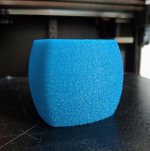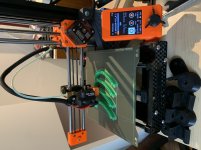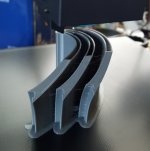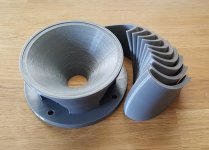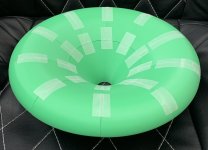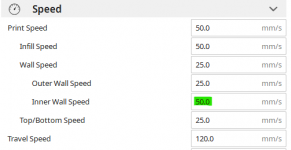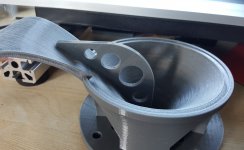Impressive stuff [emoji106]As I have it now, it would fit into 170 x 170 x 110 mm (x,y,z) build volume (e.g. Prusa MINI+ is fine).
Continuing on the ST260 (no filler, no sanding, no glue yet) -
(Wonder what angle ajustment will require the last petal. So far it looks pretty accurate.)
Fuzzy Skin texture from Cura could be option if a textured finish is acceptable.I only wish the inner surface of the base was better but it seems I can't figure out how to do that in this case.
Attachments
Thanks, OK, I'll consider that as the last option 
I will try to tweak it a little further. In the previous tests I turned off perimeter crossings and maybe that's not the best approach here, as it moves along the edge instead. At least this is what I believe is the cause.
I will try to tweak it a little further. In the previous tests I turned off perimeter crossings and maybe that's not the best approach here, as it moves along the edge instead. At least this is what I believe is the cause.
Four at once on a Prusa Mini. Petals twice as large would be possible easily. The base could be ca 1.5x larger. I am curious about the result of gluing all together. My first layer is slightly squished, so I expect that there would be some very small gaps between the petals, which would be compensated by the glue.
Attachments
Not a fan, I understand. I thought with the right colour grey it could resemble Nextel 
I have been trying Arc Welder
FormerLurker (FormerLurker) * GitHub this turns all the small straight lines into gcode arc's, which for waveguides seems like a good idea. It compresses the gcode massively so there is a lot less data being sent or processed.
I sliced the base with it so I'll let you know what it looks like when it's printed. The petal that's printing now looks pretty good.
I have been trying Arc Welder
FormerLurker (FormerLurker) * GitHub this turns all the small straight lines into gcode arc's, which for waveguides seems like a good idea. It compresses the gcode massively so there is a lot less data being sent or processed.
I sliced the base with it so I'll let you know what it looks like when it's printed. The petal that's printing now looks pretty good.
I wonder if the petals could be combined and printed like the waveguide test piece. In one, two or four pieces depending on the size of the printer.I am curious about the result of gluing all together.
Nice. Prusa Mini would probably be my choice if I was to buy a printer today.Four at once on a Prusa Mini. ...
I'm waiting for the remaining three -
Attachments
[emoji106]OK, I have it complete.
If you don't hear from me again, it didn't go right.
Filler and sand paper and paint[emoji23]
I've already found a local source for a fine brass powder (325 mesh). If that goes as I hope, it will have a great look.[emoji106]
Filler and sand paper and paint[emoji23]
Here is a filament that can be smoothed with alcohol, apparently based off PLA: PolySmooth™ - Polymaker US
Taped together. It should work, but it will require precise gluing. I think liquid nails / construction glue will work the best in this case as there are some slight gaps and it is possible to manipulate with the parts for a short while.
Attachments
Yeah, gluing it all together may be still tricky, even if the parts alone are pretty precise (which they should be). I still wonder about the best procedure. Some tools or templates can be printed for that. I'm definitely going to try a cyanoacrylate glue first, maybe a polyurethane then.
Very nice print, BTW! Is that PET-G?
Very nice print, BTW! Is that PET-G?
Last edited:
I only wish the inner surface of the base was better but it seems I can't figure out how to do that in this case.
I wonder if your default slicer settings has the inner walls run twice as fast like it was in mine?
Attachments
To me it looks like a hell on earth.
It is hard enough to make two or four pieces align without some edges sticking out that require more sanding later on. Not to mention excess epoxy glue that needs to be removed. It doesn't sand quite the same as printing material so it is easy to make damage.
It is hard enough to make two or four pieces align without some edges sticking out that require more sanding later on. Not to mention excess epoxy glue that needs to be removed. It doesn't sand quite the same as printing material so it is easy to make damage.
No but it's not a big deal, some sanding, that's all. I expect the epoxy coating to smooth the surface considerably anyway.I wonder if your default slicer settings has the inner walls run twice as fast like it was in mine?
Otherwise, the way it was printed it is quite accurate and it should not be a problem to assemble. Remember that for the ST260 this may not be necessary but this is just a verification of the concept for (much) larger devices, that simply won't fit on the bed no matter what you do. If this is a way how to make even big DIY waveguides with a common 3D printer at home (anywhere in the world at the cost of some filament and the finish), I'm all for it.
Attachments
Last edited:
- Home
- Loudspeakers
- Multi-Way
- Acoustic Horn Design – The Easy Way (Ath4)
